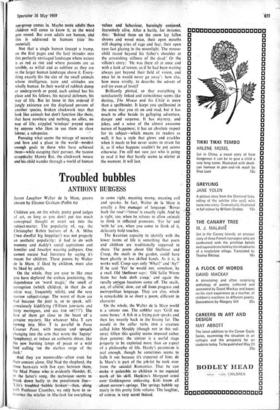Troubled bubbles
ANTHONY BURGESS
Secret Laughter. Walter de la Mare, poems chosen by Eleanor Graham (Pullin 4s) Children are, on the-whole, pretty good judges of art, so long as you don't put too much conceptual thought or overt sex into the subject-matter. The popularity of, say, the Christopher Robin horrors of A. A. Milne (Iwo dwefful big hoppities') was not properly an aesthetic popularity: it had to do with mummy and daddy's social aspirations and Jennifer and Joscelyn wearing jodhpurs. One cannot excuse bad literature by saying it's meant for children. These poems by Walter de la Mare, if liked by children, must also be liked by adults.
On the whole, they are easy to like once you have deplored the archaic poeticising, the dependence on 'word magic,' the smell of corruption (which, children, in their fin de siecle way, frequently relish), and the very narrow subject-range. The worst of them are bad because the poet is, .so to speak, self- consciously kiddifying (Fifteen jam-tarts and forty meringues, and ALL FOR ME! ). The best of them get close to the heart dr a genuine mystery, like whatever Miss T eats turning into Miss T (a parallel in Point Counter Point, with mutton -and-- .spinach changing into the arm that wrote the 'Jupiter' Symphony), or induce an authentic shiver, like the yew burning lamps of peace or a wild bird calling 'on the starless verge of the dark.'
And they are memorable—often even for their content alone. Old Nod the shepherd, the three barn-cats with five eyes between them, the Mad Prince who is evidently Hamlet. -if, in the latter's song. the technique seems to break down badly in the penultimate line— 'Life's troubled - bubble broken'—then, along with Professor Coombes, we only have to re- member the witches in Macbeth for everything
to come right, meaning wrong, meaning evil and spooky. In fact, Walter de la Mare is usually a fine, manager of language.' 'Roves back the rose=-`roves'-is-exactly right. And he is right, too, when he iefuses W allow animals', to think in inflected pronouns. 'For he' and `with he' are, when you come to think of it, delicately bold touches.
The Keatsian capacity to identify with the lower forms of life is something that poets and children are traditionally supposed to share. The poem about Old Shellover and Creep, the snails in the garden, could have been ghastly in less skilled hands. As it is, it
works well. Creep says only 'What?' and 'Ay!' If he said 'Yes' he would not, somehow, be
a snail. Old Shellover -says: 'Old Sallie Worm from her hole cloth creep,' and again the rurally antique locutions come off. The snails, are, of 074; slow, cut off from progress and metropolitan language. They are also, which is remarkable in so short a poem, different in character.
On the whole, the Walter de la Mare.world is a' sinister one. The cobbler says 'Grill me some bones.' A fish in a frying-pan speaks and then lies wearily back in the hissing fat. The mould in the cellar turns into a creature called John Mouldy (though not in this vol- ume). Often this quality seems imposed rather , than genuine; the sinister is a useful stage property to be exploited more than an aspect of a philosophy of life. Hardy's pessimism is real enough, though he sometimes seems to ladle- it out because it's expected of him; de la Mare's is part of the job-lot he took over from the suicidal Romantics. That he can make it palatable .to-children is no especial -mark of his skill, Hopkins's Margaret- cried over Goldengrove unleaving. Kids know all about sorrow's springs. The springs bubble up nicely in this pretty little volume. The laughter, of course, is very secret indeed.






































 Previous page
Previous page